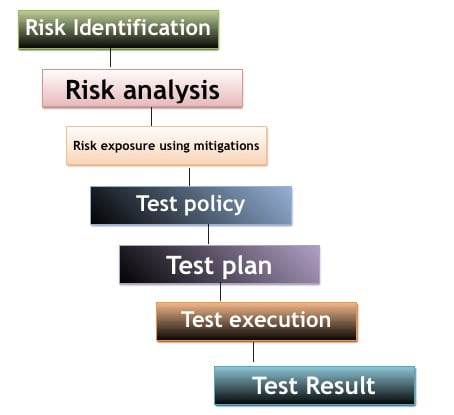Risk based testing is procedure of giving priorities for features, functions and modules of application under test based on the impact of failures. It involves analysing risk based on the complexity, business criticality and visible areas.
Risk can be negative or positive.
- Positive Risks: It is referred to opportunities that help in business sustainability. For example, investing in new project changing new processes, developing new products.
- Negative Risks: It is referred as threats and recommendations to minimise or eliminate them must be implemented for project success.
The objectives of Risk based testing are:
- To know when and how to use risk based testing
- To understand advantages and disadvantages of risk based testing.
- To understand steps of implementing the risk based testing on appropriate application.
- To make risk free project using best practices in risk management to achieve a project outcome that balances risks with quality, features, budget and schedule.
Major processes to execute risk based testing are:

Process 1: Risk identification: It describes all the requirements in terms of risk involved in the project. The projects encounter various risks which are recognised by the stake holders of the projects. These are mix of technical and business team.
Process 2: Risk analysis, Risk exposure using mitigations, Test policy– It prioritises the requirements in terms of risk assessment, once all the possible risks and their impacts are analysed the project manager will get the requirements prioritised. The priority requirements should be agreed and updated in the functional document.
Process 3: Test plan– Planning and defining the tests according to requirement priorities. When we get the requirement with the priority. We can start the test activities by keeping priorities in mind.
Process 4: Test execution & result– executing the test according to priority and acceptance criteria. If any of the identified risks realised by the test schedule time then there is a chance of schedule slippage by the development side.
Advantages of Risk based testing:
- Improved quality– All the critical functions of the applications are tested.
- Giving more focus on the risks of the business projects rather than the functionality of the information system.
- It provides the negotiating instrument to the client and test manager similar when existing means are limited.
- Associate the product risk to the requirement identifies the gap.
- Testing will focus on the most important matters first with optimal test delivery, limited time, money and qualified resources. We need to determine the better way to accelerate our testing effort with still managing the risk of the application under test.
- Improve customer satisfaction by customer involvement, good report and progress track.
Questions
- What are the types of Risk Based Testing?
- What is Risk Based Testing? Explain with an example































40 Responses
1. What are the types of Risk Based Testing? Risk based testing can be executed through analyzing risk based on complexity, business criticality, and visible areas. Furthermore, risk can be identified as either of two types: positive or negative.
Positive risks refer to opportunities that help in business sustainability.
Negative risks refer to threats (recommendations to minimize or eliminate them must be implemented for project success.)
2.What is Risk Based Testing? Explain with an example
Risk based testing is testing procedure through which priorities are given for features, functions and modules of an application under test – based on the impact of failures. It involves analyzing risk based on the complexity, business criticality and visible areas.
An example of risk-based testing: Prioritizing and emphasizing certain tests during test execution, based on the factor of risk.
Risk based analysis is a process of giving priorities to features, functions and modules of software application in the outcome of failures.
It can be a positive risk which helps the company in achieving new progress, project and products or it can be negative risk which refers to threats, recommendations to minimize or eliminate to achieve project success.
Risk based analysis is done different processes like risk identification,riak analysis, risk exposure using mitigations, test plan, test policy, test execution and result.
The goal of Risk based analysis is to balance the risk with quality, features, budget and schedule.
Risk based testing has 2 main type
1 positive risk :-Positive risks which refers to opportunities and helps in business sustainability.
2.negative risk:- It is referred as threats and recommendations to minimize or eliminate them must be implemented for project success.
Risk based testing is a procedure of testing giving priorities to features,functions,modules of application under test based on the impact of failures.It involves analyzing risk based on the complexity, business critical and visible areas.
Risk based testing is procedure of giving priorities for features, functions and modules of application under test based on the impact of failures. It involves analysing risk based on the complexity, business criticality and visible areas.
For example many projects have different constraints like time, resources, quality requirement in terms of organization standards. The risk based testing works really well in this regards. While implementing new projects there are high risk factors involved like New technology, lack of knowledge, lack of experience etc.
Types of risks:
Positive Risks: It is referred to opportunities that help in business sustainability. For example, investing in new project changing new processes, developing new products.
Negative Risks: It is referred as threats and recommendations to minimise or eliminate them must be implemented for project success.
Risk based testing is procedure of giving priorities for features, functions and modules of application under test based on the impact of failures. It involves analyzing risk based on the complexity, business criticality and visible areas.
Risk can be negative or positive.
Positive Risks: It is referred to opportunities that help in business sustainability. For example, investing in new project changing
new processes, developing new products.
Negative Risks: It is referred as threats and recommendations to minimize or eliminate them must be implemented for project success.
Risk based testing is procedure of giving priorities for features, functions and modules of application under test based on the impact of failures. It involves analyzing risk based on the complexity, business critical and visible areas.
Risk can be negative or positive.
Positive Risks: It is referred to opportunities that help in business sustainability. For example, investing in new project changing new processes, developing new products.
Negative Risks: It is referred as threats and recommendations to minimize or eliminate them must be implemented for project success.
make risk free project using best practices in risk management to achieve a project outcome that balances risks with quality, features, budget and schedule.
What are the types of Risk Based Testing?
Risk based testing is of the following types:
Positive Risk- This is a risk associated with adding new features to software, developing new products, enhancing business etc. These risks are worth taking for improvement of product or business.
Negative risk- This is the risk associated with bugs in software, functionality errors, improper integration of different modules of software etc. These risks are to be minimized as to prevent losses.
What is Risk Based Testing? Explain with an example
Risk based testing is testing done based on the risk that may arise during the process of product development.
Say we are creating a software for a bank, various positive and negative risks may arise. Positive risks could be need to meet the demands of the client, considering budget changes, infrastructure changes, manpower changes. All these are essential in order to improve business.Negative risks are bugs or defects in software, compatibility issues, functionality issues etc. These have to be identified and fixed as much as possible to sustain business.
Risk based testing involves the following steps: Risk identification, Analysis, Test implementation, Test execution and results.
Each risk should be well identified, its consequences good and bad must be analysed and a plan should be in place regarding protocols to be followed, a test should be in place to challenge the risk and a solution must be sought for the risk.
Risk based testing is procedure of giving priorities for features, functions and modules of application under test based on the impact of failures. It involves analysing risk based on the complexity, business criticality and visible areas.
Risk can be negative or positive.
Positive Risks: It is referred to opportunities that help in business sustainability. For example, investing in new project changing new processes, developing new products.
Negative Risks: It is referred as threats and recommendations to minimise or eliminate them must be implemented for project success.
What are the types of Risk-Based Testing?
Risk can be negative or positive.
Positive Risks: It is referred to opportunities that help in business sustainability.
For example, investing in new projects changing new processes, developing new products.
Negative Risks: It is referred to as threats and recommendations to minimize or
eliminate them must be implemented for project success.
What is Risk-Based Testing? Explain with an example
Risk-based testing is the procedure of giving priorities for features, functions, and modules of an application under test based on the impact of failures. It involves analyzing risk based on the complexity, business criticality, and visible areas.
Example: Walmart adds a healthcare benefit for all the employee
-Risk analyze will find the risk involved in that like financial and resource risk
over there.:
1.Types of Risk Based Testing:
(1).Positive Risks: It is referred to opportunities that help in business sustainability. For example, investing in new project changing new processes, developing new products.
(2).Negative Risks: It is referred as threats and recommendations to minimise or eliminate them must be implemented for project success.
2. Risk Based Testing:
Risk based testing is procedure of giving priorities for features, functions and modules of application under test based on the impact of failures. It involves analysing risk based on the complexity, business criticality and visible areas.
Risk based testing has two types
1- Positive Risks: It is referred to opportunities that help in business sustainability
2- Negative Risks: It is referred as threats and recommendations to minimize or eliminate them must be implemented for project success.
Risk based testing is a procedure of giving priorities for features, functions and modules of the application under test based on the impact of failures. It involves analyzing risk based on the complexity, business criticality and visible areas.
e.g. investing in a new project, changing new processes, developing new products.
1. Risk based testing is basically a testing done for the project based on risks.
Risk can be negative or positive.
Positive Risks: It is referred to opportunities that help in business sustainability.
Negative Risks: It is referred as threats and recommendations to minimize or eliminate them must be implemented for project success.
2.Risk-based testing involves both mitigation – testing to provide opportunities to reduce the likelihood of defects, especially high-impact defects – and contingency – testing to identify work-arounds to make the defects that do get past us less painful.
eg) investing in new project changing new processes, developing new products.
Types of Risk based testing are : Positive Risks
Negative Risks
Risk based testing is procedure of giving priorities for features, functions and modules of application under test based on the impact of failures. It involves analyzing risk based on the complexity, business criticality and visible areas.
1) types of Risk Based Testing : risk based on complexity, business criticality, and visible areas.
risk can be identified as either of two types: positive or negative.
a) Positive risks refer to opportunities that help in business sustainability.
b) Negative risks refer to threats and recommendations to minimize or eliminate them must be implemented for project success.
2) Risk Based Testing : testing type done based on the probability of risk.
ex: investing in a New project, Changing business processes, Developing new products.
Question: What are the types of Risk Based Testing?
Positive Risks: It is referred to opportunities that help in business sustainability.
Negative Risks: It is referred as threats and recommendations to minimize or eliminate them must be implemented for project success.
Question: What is Risk Based Testing? Explain with an example
Risk based testing is procedure of giving priorities for features, functions and modules of application under test, based on the impact of failures. It involves analyzing risk based on the complexity, business criticality and visible areas.
For example, if an application fails to process payment for customer order, order may not go through to finalize sale.
The types of risk based testing are: Project risks (problems other than those in the software.) and product risks (risks in the specific quality characteristics of the software.)
Risk based Testing is a procedure of giving priorities to functions, features and modules of application under test based on the impact of failures. It involves risks based on the complexities, critical and visible areas.
1). There is two types of Risk Based Testing that is Positive and Negative.
Positive Risks: It is referred to opportunities that help in business sustainability. For example, investing in new project changing new processes, developing new products.
Negative Risks: It is referred as threats and recommendations to minimise or eliminate them must be implemented for project success.
2).Risk based testing is procedure of giving priorities for features, functions and modules of application under test based on the impact of failures. It involves analysing risk based on the complexity, business criticality and visible areas. eg investing in a new project, changing new processes, developing new products.
Risk based testing-Risk based testing is basically a testing done for the project based on risks. Risk based testing uses risk to prioritize and emphasize the appropriate tests during test execution. In simple terms – Risk is the probability of occurrence of an undesirable outcome. This outcome is also associated with an impact.
For example investing in a New project, Changing business processes, Developing new products.Type of risk testing-negative and positive.Negative risk cause negative impact on project which will lead to no development or business.Positive risk causes positive impact.
1 types of Risk-based testing: positive and Negative
positive risk: this will help in business sustainability, help in improving
Negative risk: this testing will eliminate threats to minimize, must be implanted into the success of the project.
2 what is risk-based testing:risk-based testing is the procedure to giving priorities under test based on the impact of failures.involving analysis of risk
example: making new software or function in an ATM machine always use risk-based testing to check for positive and negative Risk analysis.
The type of risk based testing is positive risk and negative risk. It’s type of testing which is based on probability of risk
Question: What are the types of Risk Based Testing?
Positive Risks: It is referred to opportunities that help in business sustainability.
Negative Risks: It is referred as threats and recommendations to minimize or eliminate them must be implemented for project success.
Question: What is Risk Based Testing? Explain with an example
Risk based testing is procedure of giving priorities for features, functions and modules of application under test, based on the impact of failures. It involves analyzing risk based on the complexity, business criticality and visible areas.
For example, if an application fails to process payment for customer order, order may not go through to finalize sale.
Risk based testing is a type of testing where the features and functions to be tested are based on the priority, importance and potential failures. It can be positive and negative, if it improves the end product business and its positive testing while it can be negative if the testing adds up to the cost and does not produce any results.
What are the types of risk based testing?
Risk can be negative or positive.
Positive Risks: It is referred to opportunities that help in business sustainability. For example, investing in new project changing new processes, developing new products.Negative Risks: It is referred as threats and recommendations to minimise or eliminate them must be implemented for project success.
What is Risk Based Testing? Explain with an example
Risk based testing is procedure of giving priorities for features, functions and modules of application under test based on the impact of failures. It involves analysing risk based on the complexity, business criticality and visible areas. For example, investing in a new project or developing a new product.
Risk-Based Testing is a testing strategy that follows the principles of Risk Management but in a testing context. The main purpose of RBT is to use risk management principles for adequate testing. It provides a framework for clear communication and discussion about risks between testers, developers, clients and stakeholders. RBT will help you define terms and agree on a common language, and through this it will make risk visible and actionable for you. It also takes into consideration the big picture, as it covers customer needs and also the needs of the development team. It specifically uses risks as the input to support testing activities.
What are the types of Risk Based Testing?
Risk based testing can be – Positive or Negative.
Positive Risk refers to opportunities that help the business grow and sustain – such as investing in developing new products or adopting new processes.
Negative Risks refers to threats to the software and the steps taken to eliminate them.
What is Risk Based Testing? Explain with an example
Risk-based testing (RBT) is a type of software testing that functions as an organizational principle used to prioritize the tests of features and functions in software, based on the risk of failure, the function of their importance and likelihood or impact of failure.
For example – clicking on a link that takes to to the next page is very low risk compared to an extremely high risk situation when one is transferring funds from one account to another.
Risk taking ability also varies from industry to industry – such as pace makers and air control to financial and educational.
1) Risk can be negative or positive.
Positive Risks: It is referred to opportunities that help in business sustainability. For example, investing in new project changing new processes, developing new products.
Negative Risks: It is referred as threats and recommendations to minimize or eliminate them must be implemented for project success.
2) Risk based testing is procedure of giving priorities for features, functions and modules of application under test based on the impact of failures. It involves analyzing risk based on the complexity, business criticality and visible areas.
Example: Prioritizing and emphasizing certain tests during test execution, based on the factor of risk
Risk can be negative or positive.
Positive Risks: It is referred to opportunities that help in business sustainability. For example, investing in new project changing new processes, training, developing new products.
Negative Risks: It is referred as threats and recommendations to minimize or remove them. These must be implemented for project success.
Risk Based Testing is a procedure of giving priority to features, functions and modules of application based on the impact of failures. It involves analyzing risk based on the complexity, business criticality and visible areas.
Take the example of a new OS upgrade on your PC or mobile. After upgrade there may be a functionality that is not working because of a bug. This is fixed with a later bug fix update. In the meantime, user will continue using the software and it does not affect the business in a big way. This is achieved by Risk based testing.
Two types of risk based testing are Positive risks and Negative risks.
Risk based testing is procedure of giving priorities for features, functions and modules of application under test based on the impact of failures. It involves analyzing risk based on the complexity, business criticality and visible areas.
1.Positive Risks: It is referred to opportunities that help in business sustainability. For example, investing in new project changing new processes, developing new products.
Negative Risks: It is referred as threats and recommendations to minimize or eliminate them must be implemented for project success.
2.Risk based testing is procedure of giving priorities for features, functions and modules of application under test based on the impact of failures. It involves analyzing risk based on the complexity, business criticality and visible areas.
example: lets consider Facebook or any social media applications one of the functionality is not working eg:commet option is not opening,no photo or video uploading or any other issue ,but the user can still use the app along with that the bugs/errors will be fixed by new update,
Risk can be positive or negative.positive risks is referred to opportunities that help in business sustainability.Negative risks
referred as threats & recommendations to minimise or eliminate them must be implemented for project success.
Risk based testing is procedure of giving priorities for features,functions & modules of application under test based on the
impact of failures.it involves analysing risk based on the complexity,business criticality and visible areas.For example, investing
in new project changing new processes,developing new products.
1. Types of risk based testing:
-> Positive risks: Refers to opportunities that help in business sustainability
-> Negative risks: Refers to the risks or threats to the software and recomendations to minimise or eliminate them
2. Risk based testing is procedure of giving priorities for features, functions & modules of application under test based on the impact of failures. It involves analysing risk based on the complexity, business criticality and visible areas.
1. The two types of risk based testing are positive risks and negative risks. Positive risks involves opportunities that help in business sustainability, while negative risk involves threats that should be minimized or eliminated for project success.
2. Risk based testing is procedure of giving priorities for features, functions and modules of application under test based on the impact of failures. It involves analyzing risk based on the complexity, business criticality and visible areas. An example of this would be to prioritize certain feature over other during testing for the purpose of importance.
What is Risk Based testing? Explain with an example. What are the types of risk based testing?
Answer: Risk based testing is a procedure to identify and analyze a risk and give priority on features, functions and module of application based on the impact of the failures.
Types of risk based testing:
Positive-> Positive risk based testing help to increase the sustainability of business through changing process or developing new products.
Negative-> It minimize or eliminate the threats and make the application risk free.
1.What are the types of Risk Based Testing?
There are two kind of Risk Based Testing :-
1)Positive Risks: It is referred to opportunities that help in business sustainability. For example, investing in new project changing new processes, developing new products.
2)Negative Risks: It is referred as threats and recommendations to minimize or eliminate them must be implemented for project success.
2.What is Risk Based Testing? Explain with an example
Risk based testing is procedure of giving priorities for features, functions and modules of application under test based on the impact of failures. It involves analyzing risk based on the complexity, business criticality and visible areas.
Example: Investing in new project changing new processes, developing new products.
Risk based testing is procedure of giving priorities for features, functions and modules of application under test based on the impact of failures. It involves analyzing risk based on the complexity, business criticality and visible areas. For example, investing in new project changing new processes, developing new products. Types of RBT: 1)Positive Risks: It is referred to opportunities that help in business sustainability. 2)Negative Risks: It is referred as threats and recommendations to minimize or eliminate them must be implemented for project success.
1.Risk can be negative or positive.
Positive Risks: It is referred to opportunities that help in business sustainability. For example, investing in new project changing new processes, developing new products.
Negative Risks: It is referred as threats and recommendations to minimise or eliminate them must be implemented for project success.
2.Risk based testing is procedure of giving priorities for features, functions and modules of application under test based on the impact of failures. It involves analysing risk based on the complexity, business criticality and visible areas.
1. What are the types of Risk Based Testing?
Risk can be negative or positive.
Positive Risks: It is referred to opportunities that help in business sustainability. For example, investing in new project changing new processes, developing new products.
Negative Risks: It is referred as threats and recommendations to minimize or eliminate them must be implemented for project success.
2. What is Risk Based Testing? Explain with an example
Risk based testing is performed based on the identification of risks involved in the project. Risk is the possibility of failure in the projects. Risk is the occurrence of the uncertain events with the positive or negative effect. This uncertain effect could have impact on business, cost, technical and quality targets of the projects.
1. What are the types of Risk-Based Testing?
there are 2 types of risks.
Positive risks: Refers to opportunities that help in business sustainability
Negative risks: Refers to the risks or threats to the software and recommendations to minimize or eliminate them
2. What is Risk-Based Testing? Explain with an example
Risk-based testing is the procedure of giving priorities for features, functions & modules of an application under test based on the impact of failures. It involves analysing risk based on the complexity, business criticality and visible areas.
1. What are the types of Risk Based Testing?
Positive risks: it refers to opportunities that help in business sustainability. For example: investing in new projects, changing new processes, developing new products.
Negative risks: it refers as threats and recommendations to minimize or eliminate them must be implemented for project success.
2. What is risk-based testing? Explain with example?
Risk Based Testing is a software testing type which is based on the probability of risk. It involves assessing the risk based on software complexity, criticality of business, frequency of use, possible areas with defects etc. Risk based testing prioritizes testing of features and functions of the software application which are more impactful and likely to have defects.
Example: banking mobile app where the risk could be security vulnerabilities in software which could lead to data breaches.
Risk Based Testing types:
1.positive risks – It is referred to opportunities that help in business sustainability. For example, investing in new project changing new processes, developing new products.
2.Negative Risks: It is referred as threats and recommendations to minimise or eliminate them must be implemented for project success.
Risk Based Testing :Risk based testing is procedure of giving priorities for features, functions and modules of application under test based on the impact of failures. It involves analyzing risk based on the complexity, business criticality and visible areas.
Advantage of Risk Based Testing is to improve the quality and ensuring the customer is satisfied with the end product .